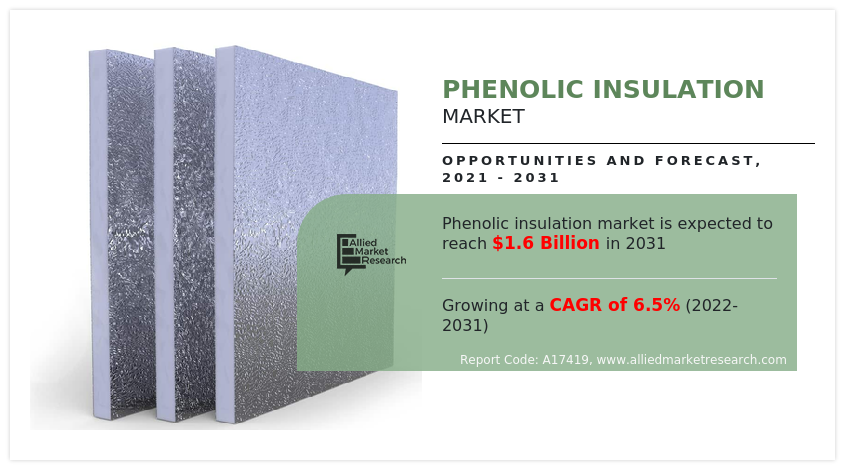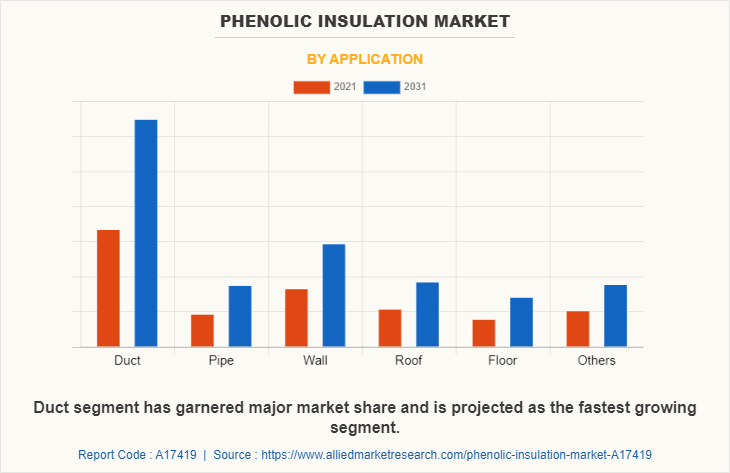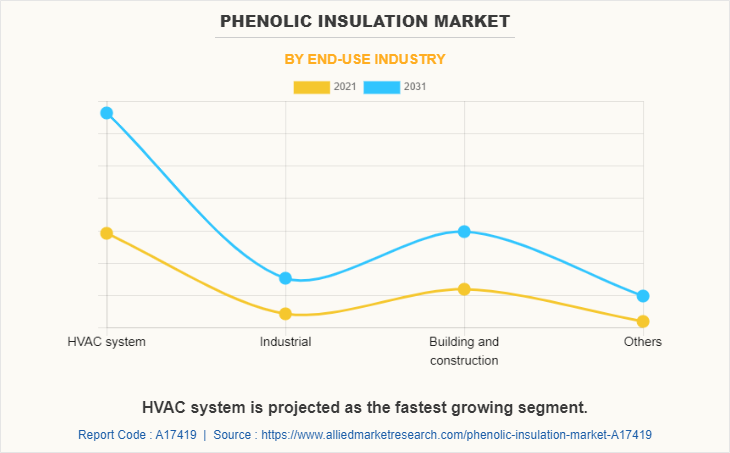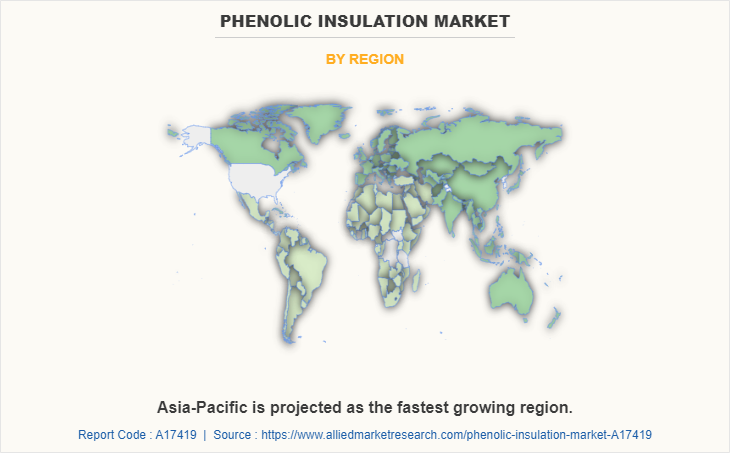Phenolic Insulation Market Research, 2031
The global phenolic insulation market was valued at $0.9 billion in 2021 and is projected to reach $1.6 billion by 2031, growing at a CAGR of 6.5% from 2022 to 2031.
A plastic foam forms an insulating core between two flexible tissue-faced layers in the production of phenolic insulation. It has a high proportion of closed cells and a fine cell structure. To produce rigid phenolic insulation, high solids and phenolic resin are combined with a surface-acting agent.
It is widely used for characteristics, such as fire resistance, high durability, low smoke emission at high temperatures, and chemical resistance, and it can be used in insulation layers for insulation systems and HVAC air ducts as padding material for fireproof doors and many other applications. The definition of phenolic insulation is a structure with closed cells and superior thermal characteristics. The low thermal conductivity and light weight of phenolic insulation make it possible to achieve excellent insulation efficiency with minimal thickness. Compared to other organic insulation, phenolic insulation has distinct fire-retardant characteristics. Low smoke density, low flammability, and toxicity are included in phenolic insulation.

The rising demand for infrastructure development in the residential and commercial sectors is the primary factor propelling market expansion. In addition, the rise in environmental concerns is driving the demand for phenolic insulation as it reduces CO2 emissions significantly. However, the high price of insulation may hinder market expansion. Phenolic insulation, also known as phenolic panels, is a type of plywood-like material created using woven fabrics or high-density thermo-setting cellulose fabrics in conjunction with phenolic resins. Very high pressure is used to press woven cellulose fabrics with phenolic resins to create these boards.
The rebound in residential construction will fuel the expansion of the construction industry, which is anticipated to have a positive impact on the phenolic insulation market's growth rate. The increasing population growth and the rapid urbanization rate in emerging regions have accelerated building and construction activities globally, which is a key factor driving the market's growth during the forecast period. Various manufacturers are adopting new techniques to convince phenolic resins to meet the needs of end-use industries, which has a significant impact on the growth of the market.
Depending on the application, the market is categorized into duct, pipe, wall, floor, roof, and others. On the basis of end-use industry, the market is categorized into HVAC systems, building & construction, industrial, and others. On the basis of region, the market is studied across North America, Europe, Asia-Pacific, and LAMEA.
Major players operating in the global phenolic insulation market include Armacell, Asahi Kasei Corporation, BASF SE, Beijing Coowor Network Technology Co., Ltd., Covestro AG, Dow Inc, Guibao, Huntsman Corporation, Johns Manville, Kingspan Group, LX Hausys, Owens Corning, Saint-Gobain, Sekisui Chemicals Co., and Ltd, SQ Group. Other players operating in the Phenolic insulation market are Jinan Shengquan Group, Unilin(Xtratherm), Lapolla Industries, Inc., and Recticel Group.
The phenolic insulation market is segmented into the Application and End-Use Industry.

The duct segment accounted for the largest share i.e., 38.2%, and is the fastest growing segment, growing around 7.0% CAGR during the forecast period, this is due to the increased demand from the construction industry.

The HVAC system segment accounted for the largest share i.e., 44.9%, and is the fastest growing segment, growing around 7.0% CAGR during the forecast period. This is due to the increase in the usage of HVAC systems in commercial sectors and data centers, schools & hospitals.

Asia-Pacific contributed 49.3% market share in 2021 and is projected to grow at a CAGR of 7.6% during the forecast period. Owing to the increased demand for HVAC systems, industrial and building & construction industries.
COVID-19 impact analysis on the global phenolic insulation market
There is an uneven impact of the COVID-19 pandemic on the phenolic insulation market, owing to the implementation of lockdowns worldwide to halt the spread of the virus. This resulted in the shutting off of almost all operations, manufacturing, and distribution of all industries. This has resulted in a decrease in demand from the construction industry which, in turn, has led to sluggish growth of the market.
However, now the governments around the world are encouraging businesses in the construction sector to resume operations with supporting taxes and regulations, these businesses are attempting to recover the market in anticipation of a gradual increase in sales in 2021.
Key Benefits For Stakeholders
- This report provides a quantitative analysis of the market segments, current trends, estimations, and dynamics of the phenolic insulation market analysis from 2021 to 2031 to identify the prevailing phenolic insulation market opportunities.
- Market research is offered along with information related to key drivers, restraints, and opportunities.
- Porter's five forces analysis highlights the potency of buyers and suppliers to enable stakeholders to make profit-oriented business decisions and strengthen their supplier-buyer network.
- An in-depth analysis of the phenolic insulation market segmentation assists to determine the prevailing market opportunities.
- Major countries in each region are mapped according to their revenue contribution to the global market.
- Market player positioning facilitates benchmarking and provides a clear understanding of the present position of the market players.
- The report includes an analysis of the regional as well as global phenolic insulation market trends, key players, market segments, application areas, and market growth strategies.
Phenolic Insulation Market Report Highlights
| Aspects | Details |
| Market Size By 2031 | USD 1.6 billion |
| Growth Rate | CAGR of 6.5% |
| Forecast period | 2021 - 2031 |
| Report Pages | 265 |
| By Application |
|
| By End-Use Industry |
|
| By Region |
|
| Key Market Players | BASF SE, Saint-Gobain, LX Hausys, sq group, johns manville, armacell, Huntsman Corporation, Kingspan Group, DOW INC, Guibao, Owens Corning, covestro ag, Beijing Coowor Network Technology Co., Ltd., Sekisui Chemicals Co., Ltd, Asahi Kasei Corporation |
Analyst Review
According to the perspective of the CXOs of leading companies, the global phenolic insulation market is projected to witness a significant growth rate. There are numerous applications for phenolic insulation, including duct, pipe, wall, floor, and roof. The industrial sector can achieve high thermal insulation, fireproof, good chemical resistance, higher environmental performance, and reduced emission and harmfulness products with the use of phenolic insulations such as phenolic insulation, phenolic insulation cardboards, and others. Moreover, phenolic insulation is utilized in HVAC air ducts and as packing material for petroleum, chemical products, gas, heating, and water pipes. In addition, it is an essential component of cold storage and refrigerated vehicles. Furthermore, the popularity of phenolic insulation for generating fireproof insulating materials, damp and sound insulating materials, and others has increased as the building sector has grown. C-suite executives said that continued economic growth and the expansion of the personal hygiene industry have fueled the need for phenolic insulations.
Increased demand from the construction industry and rapid industrialization are the key factors boosting the phenolic insulation market growth.
Ducts and Pipes are the leading application of the phenolic insulation market.
Asia-Pacific is the largest regional market for phenolic insulation.
The phenolic insulation market was valued at $0.9 billion in 2021 and is projected to reach $1.6 billion by 2031, growing at a CAGR of 6.5% from 2022 to 2031.
Armacell, Asahi Kasei Corporation, BASF SE, Covestro AG, Dow Inc, and Huntsman Corporation are some of the top companies in the phenolic insulation market.
Increasing demand from HAVC systems is expected to drive the adoption of phenolic insulation.
COVID-19 had a negative impact on the phenolic insulation market owing to decreased demand from the construction industry as many projects were postponed owing to the COVID-19 pandemic.
Loading Table Of Content...



